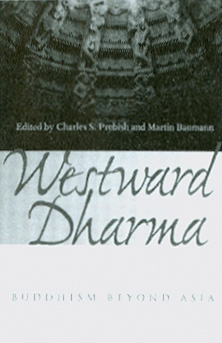 Westward Dharma: Buddhism Beyond Asia
Westward Dharma: Buddhism Beyond Asia
Charles S. Prebish and Martin Baumann
Berkeley: University of California Press, 2002
436 pp.; $21.95 (paper)
For many Westerners interested in Buddhism, the question of Buddhism’s adaptation to non-Asian environments and sensibilities is a topic of a good deal of discussion and concern. How can Buddhism flourish without a strong (and native-born) monastic tradition? Can Buddhists chant in English, Spanish, or French? How are power and gender inequities to be resolved? And perhaps most intriguing of all—what is the shape of Buddhism to come?
Westward Dharma, a new volume co-edited by Charles Prebish and Martin Baumann, attempts to tackle these and other pressing questions about Buddhism’s spread outside of Asia. Prebish has pioneered the study of Buddhism in North America, so whenever he releases a fresh volume, it is sure to set a new standard in the field. This book comes as increasingly sophisticated scholarly works on Western Buddhism have proliferated, among them Luminous Passage: The Practice and Study of Buddhism in America (Prebish, 1999),The Faces of Buddhism in America (Prebish and Kenneth Tanaka, 1998), American Buddhism: Methods and Findings in Recent Scholarship (Duncan Williams and Christopher Queen, 1999), and Buddhism in America (Richard Seager, 1999). Appropriately, most of the chapters in Westward Dharma expand on previously identified trends, deepening scholarly knowledge of Western Buddhism’s history, philosophy, and practices.
Perhaps the first question that arises when trying to understand the enormous breadth of Buddhism in the West is: “What exactly is the West, anyway?” Prebish and Baumann try to set a few parameters, but in practice it appears to be virtually anywhere outside of Asia: the USA, Canada, Europe, Brazil, New Zealand, South Africa, etc. Even Israel, which does lie on the Asian continent, is thrown in. With such a wide variety of countries, all of which have received various types of Buddhism in different time periods, it’s little surprise that Prebish and Baumann’s contributors have uncovered a large number of different Western Buddhisms, springing from many separate lineages, histories (both national and sectarian), and locations.
The book falls roughly into two sections: Parts 1-3 profile the history of Buddhism in various Western societies and deal with theories of investigation and classification. This section is a welcome expansion of previous efforts, demonstrating a heightened conceptual understanding of Buddhism and Buddhists outside Asia, as well as continuing research into the forms that Buddhism takes in these areas. This section includes excellent scholarly work, representing the cutting edge of the emergent field of Western Buddhist Studies. There is a growing complexity of categories, for instance, in Thomas Tweed’s recognition of the important contributions from large but marginal groups such as Buddhist sympathizers, or in Douglas Padgett’s insight that the transnational, modernist Buddhisms of Asian-American “ethnic” temples are often quite different from their respective Old Country paradigms.
Less steady is the second section, parts 4-5, which attempt to probe ongoing issues specific to Buddhism in the West, such as discrimination, feminization, and the lay/monastic split. Although there are some strong contributions in this section (most notably Ian Harris’s essay on Buddhist influences in Western arts), many of the essays are noticeably biased in their presentation of the issues, at times engaging in outright apologetics. Here the title of the book shifts from a statement of research interests to a battle cry. For instance, Judith Simmer-Brown’s chapter on “Women’s Dharma” concludes that feminist influences on Western Buddhism could fade, and “Frankly, it is up to us to make sure that does not happen.” Here there isn’t even a pretense of academic rigor, and unfortunately Simmer-Brown’s agenda causes her chapter to offer little more than a laundry list of who’s who among contemporary Western Buddhist women; her contribution becomes excessively anecdotal and presents no original research.
Perhaps the most regrettable aspect of the book is the total exclusion of contributors of Asian ancestry. Although many of the academics in the book acknowledge that Asian immigrants and their descendants are the overwhelming majority of Buddhists in most Western countries, there is still a considerable slant toward studying and normalizing convert groups dominated by Buddhists of European ancestry.
Ultimately, the clearest message of Westward Dharma is the extraordinary diversity that characterizes Buddhism in the West. Those who hope for a new Western Buddhism need not worry anymore—Prebish and Baumann’s contributors have shown that we already have a plethora of Western Buddhisms, from the Pure Land-derived Buddhist Churches of America to the Canadian-based Shambhala community to the People-Who-Meditate-Once-A-Week Group of Jerusalem. The book also dispels the dream of a unified, distinctively Western form of future Buddhism: just as Buddhism in the West grows from the roots of a great many different Asian traditions, so too will its Buddhist future be characterized by an ever-increasing diversity of practice and philosophy as new groups arrive, innovations arise, and indigenous forms of dharma spring forth from the fertile lands of the West.
Thank you for subscribing to Tricycle! As a nonprofit, we depend on readers like you to keep Buddhist teachings and practices widely available.